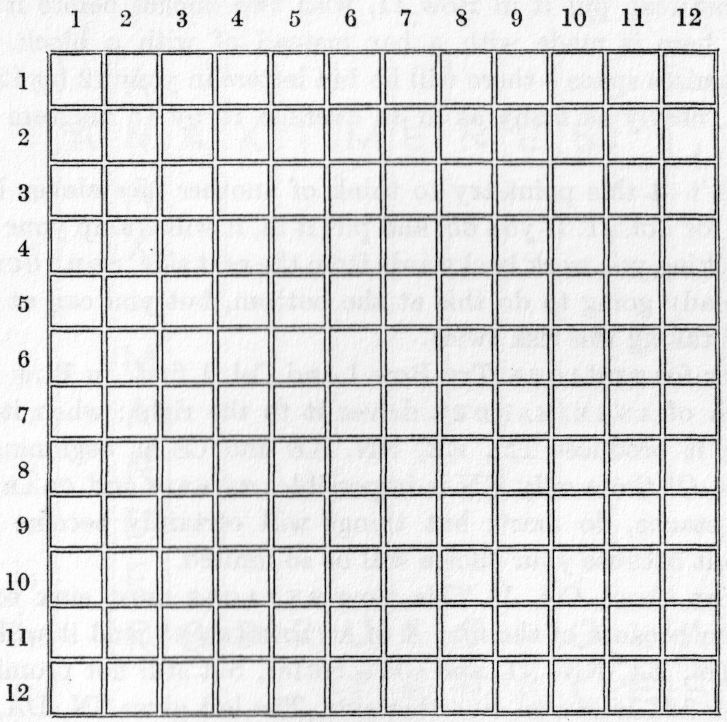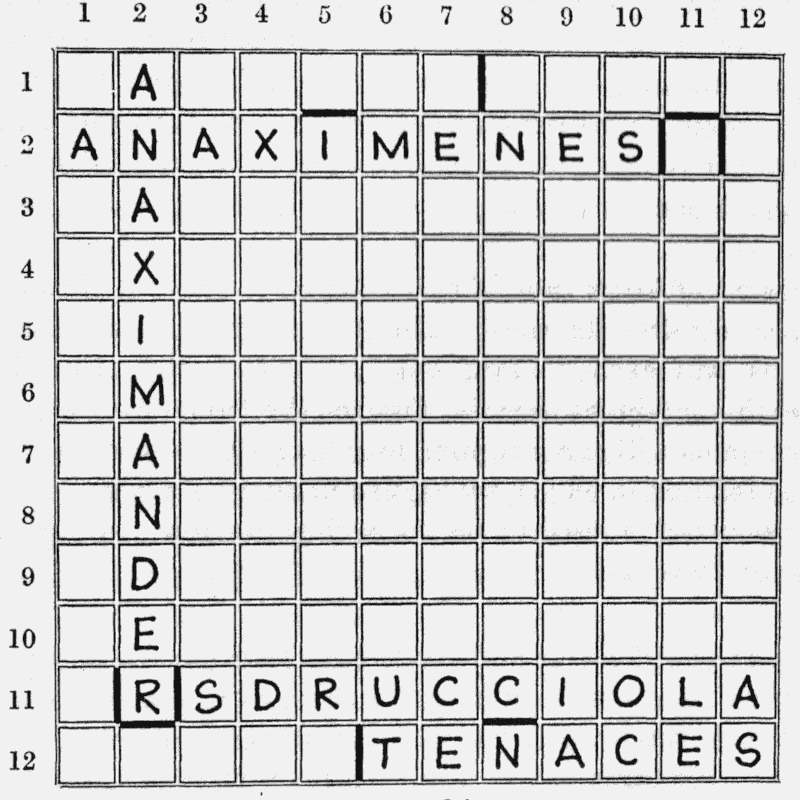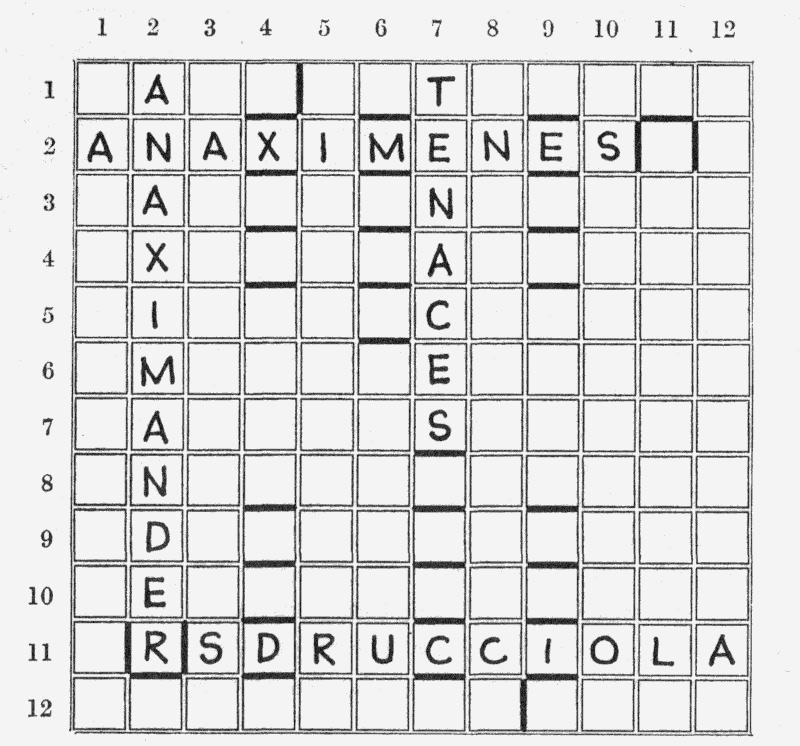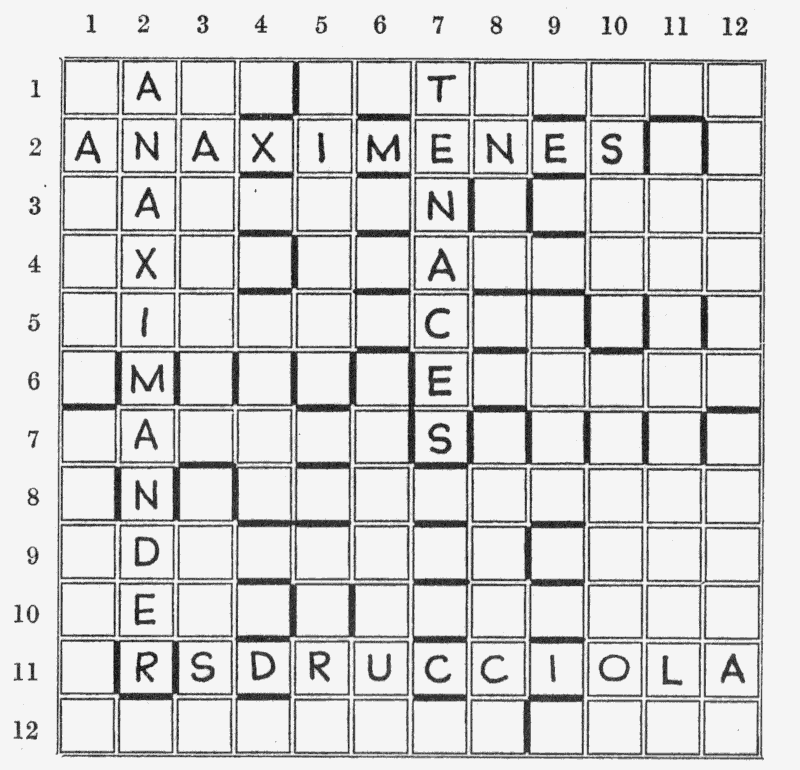Ximenes On The Art Of The Crossword
Composing a Ximenes, the bars
If you are like many people I have talked to, you probably think that the task now set you is beyond not only you but anyone except a slightly deranged specialist. I hope to show you that it isn’t. It is harder than the Everyman task in some ways: for example, in settling the diagram you will need more discretion, and you will have to think of more things at the same time. If you play golf, you know how hard it is to concentrate on looking at the ball, slow back, not swaying, not pressing, bracing your left side, following through, and so on, all at once. You may play best when you only think about one of them. That won’t work in composing this kind of crossword. What you have to do is much more like what you had to do at school, if you ever suffered from having to write Latin verse. Such sufferers have to think of scansion, grammar, syntax, word-order, intelligibility, and the meaning of the English, all at once. And if, like me, you are the sort of lunatic who enjoys trying to do that, you will certainly enjoy doing this. Is the converse also true? I hope not, because in other ways this task is easier than the Everyman task: for example, you never have to say to yourself “That word won’t do: someone may not have heard of it.” Within the limits of Chambers’s Dictionary, no holds are barred. And talking of bars, you will find that bars are, on the whole, more flexible than blocks.
Provide yourself first with a diagram, entirely blank and 12 squares by 12. Number the rows and columns as Everyman told you to, outside the diagram.

We will suppose that you have decided to include the Greek philosophers ANAXIMENES (for obvious reasons) and ANAXIMANDER (to go with him), SDRUCCIOLA (solvers like extraordinary-looking words) and TENACES (six of which will go up a card-sharper’s sleeve in their clue). Their positions in the diagram must be tentatively settled first.
The three long words are all unsuitable for the rows and columns at the extreme edges. They have too many vowels to be helpful in Row 1 or Col. 1 and too many difficult ending letters for Row 12 or Col. 12, e.g. I, U, X (and even A and O are none too common).
ANAXIMENES and ANAXIMANDER can cross each other almost anywhere, so put ANAXIMENES in Row 2, with two unches after him, and ANAXIMANDER in Col. 2, with one unch under him. Why? Remember the principle that it is easier to work away from beginnings than up to endings.
That will also fix SDRUCCIOLA: since the diagram must be symmetrical, put it in Row 11, with two unches before it. (An unch here is made with a bar instead of with a block. This economizes space — there will be 144 letters in your 12 by 12 diagram, nearly as many as in an average 15 by 15 diagram with blocks.)
Don’t at this point try to think of another nice eleven-letter word for Col. 11. If you do, and put it in, it will cramp your style by making you work backwards from the east side. SDRUCCIOLA is already going to do this at the bottom, but you can at least avoid taking this risk twice.
Now for TENACES. Try Row 1 and Col. 1 first. In Row 1 the first A of ANAXIMANDER drives it to the right: when it gets there, it produces TM, EE, NN, AE and CS as beginnings of words. Of these only NN is impossible: TMESIS and CSARDAS, for instance, do exist; but things will certainly become very difficult because your choice will be so limited.
What about Col. 1? This time TENACES must sink to the bottom because of the first A of ANAXIMENES, and it will give you TM, EA, NN, AD and CE — better, but still not promising.
Row 12% It.can go on either side. The left gives SN, DA, RC, UE and CS as endings — hopeless. The right gives UT, CE, CN, IA, OC, LE and AS — much better: only CN is impossible and only OC is difficult. Put it in tentatively, with a bar between C and N, a corresponding bar above the I of ANAXIMENES, a bar to the left of TENACES and a corresponding bar as before, after the seventh square of Row 1.
You have now reached Fig. 21 (I hope). Have a break — have some elevenses.
The next thing is to complete the diagram with bars, remembering, as you do it, all the instructions you were given by Everyman and some others which didn’t apply there.
1. Number of unches in a word. Every word should have at least one unch, so that it won’t solve itself without being able to say to the solver “You must look at my clue before you finish me”.
Sometimes it will solve itself even with unches, when only one

word will fit, e.g. P-T-TO. No one can help that, but you can prevent BEAN from solving itself by making it -EAN, B-AN, BE-N, or BEA-. On the other hand, anything but a low proportion of unches is unfair in a crossword containing unfamiliar words, as this one will. A good proportion is:
- 4 and 5 letters, 1 unch.
- 6 and 7 letters, 1 or 2 unches.
- 8 and 9 letters, 2 or 3 unches.
- 10, 11 and 12 letters, 3 or 4 unches.
There will then be between 40 and 70 unches in all: 52 or 54 is ideal. Three-letter words are rarely used: when they are, it is perhaps fairest to leave them fully checked and let them solve themselves if they like.
2. Wide open spaces. These are very dangerous. You want to be able to choose words, not to be reduced more often than is necessary to using the only possible word. You will give yourself most freedom by distributing bars fairly evenly over the diagram, and by not letting two or more longish words run side by side over much of their courses.
3. Number of words in a 12 by 12 diagram with bars. The normal number is thirty-six words. This means that six rows and six columns will each contain only one word: the other twelve will each contain two words. Four of the twelve one-word rows and columns will contain your four long words: the other eight will be reduced in length by bars to fit shorter words.
Now we can proceed to the bars: they are now, perhaps, open, so pause for a pint.
Begin by unchecking difficult-looking letters in ANAXIMENES. You need three unches in Row 2, so that he will have the normal ration for a ten-letter word. Where shall they go?
Choose the three letters of ANAXIMENES which are likely to be most tiresome as second letters of down words. These will be consonants: X, M and S are the worst, N being common as a second letter. But you can’t uncheck any of them: if you do, you will have two consecutive unches, and this is not allowed. So you must uncheck three helpful letters and leave open all the unhelpful ones, which is absurd. So the bar above I in Col. 5 must go, and TENACES must be moved, since you must preserve symmetry, and the CN ending at the bottom of Col. 8 is impossible. Expunge TENACES: where shall it go? It may as well use a letter that is already in position, so try one of the Es of ANAXIMENES, the first one for choice. You want to keep away from the eastern edge for as long as possible. Put it into Col. 7, a bar below it, and a corresponding bar below the fifth letter of Col. 6.
Now back to the top two rows. Put bars above and below X and M: this is possible now that you have got rid of the bar above I.
There is already a bar under the third square below M; so join up by putting in two more horizontal bars — very good exercise.
Before you can fix the third unch, you must settle where the break between words is to come in Row 1. There are only three possibilities — after four squares, after six squares and after eight squares. (If you put the break after five or seven squares, either the five-letter word will have two unches or the seven-letter word will have three: try, and see). With the break after six squares, the first six-letter word will have its fourth and sixth letters unchecked, and therefore the corresponding word in Row 12 will have its first and third letters unchecked: this is not actually forbidden, but it is rather unkind to the solver, as you probably know from your own experience. With the break after eight squares, the eight-letter word will run its whole course side by side with ANAXIMENES — uncomfortable, since you will have to find a word of which five letters must fit those of another word. So put a bar after four letters of Row 1, and its fellow after eight letters of Row 12. There are now no apparent snags.
You are left with a choice between the second N and the second EK for the third unch. There is not much to choose, though E is a vowel, because of the commonness of N as a second letter: you will soon learn that N is a friend everywhere except at the beginning of a word, where it is the most hostile common letter.
So spread your bars as widely as possible and choose the second E: put four bars experimentally at the top of Col. 9. I needn’t tell you what to do next. Then you may as well make the bars at the top of Col. 4 up to four, and again I needn’t tell you …
Finally, don’t forget the bottom of Col. 7.
You have now reached Fig. 22; check to see that you really have.
Congratulations on a good morning’s work. Let’s have lunch.
It’s half past two: wake up now and get on. Count the horizontal bars. There are 28. Now we said on p. 107 that the ideal total number of unches was 52 or 54, and you will need at least one each in Rows 6 and 7. That will mean 30 unches in the acrosses: you will therefore try to have not more than 24 in the downs. How many are there already? Only 4: so decide now on some more, starting on ANAXIMANDER, who should have three.

Uncheck the awkward-looking X? If so, you will either introduce another pair of ten-letter words — difficult — or a nine-letter word with its first and third letters unchecked — to be avoided if possible. Why not two words in that row? Because there are three unches in it already, and the proportions will be bad. Then try M and N, the only consonants left except D, which is to be avoided, you know now why.
Now continue eastwards. Col. 3 will need at least two unches, so you must put another bar each in Row 6 and Row 8. The four-letter word in Col. 4 will need one unch: choose the second letter rather than the fourth, because it is kinder to the solver to leave both ends open whenever you conveniently can. Continue with two more vertical bars. When you complete the symmetry, you will see why you can’t go any further.
Now count: twenty-two unches in the downs, which may well lead to an ideal total. We decided above that there must be at least one unch in Row 6: can we fix it yet? Nearly: the only possible places are in Col. 8 and Col. 10. Any preference? Yes: if you put it in Col. 10, no more unches will be possible, and you will be left with a nine-letter word in Row 5 with only one unch.
So put it in Row 8, and you can then uncheck the square above it.
Finally you must divide Rows 3 and 4 and Cols. 1 and 3 into two words each. Starting in Row 3, observe that the eighth square is so far destined to hold the third letter of a fully checked four-letter word: it is always most essential to uncheck one letter rather than the fourth, because it is kinder to the solver to leave both ends open whenever you conveniently can. Continue with two more vertical bars. When you complete the symmetry, you will see why you can’t go any further.
Now count: twenty-two unches in the downs, which may well lead to an ideal total. We decided above that there must be at least one unch in Row 6: can we fix it yet? Nearly: the only possible places are in Col. 8 and Col. 10. Any preference? Yes: if you put it in Col. 10, no more unches will be possible, and you will be left with a nine-letter word in Row 5 with only one unch.
So put it in Row 8, and you can then uncheck the square above it.
Finally you must divide Rows 3 and 4 and Cols. 1 and 3 into two words each. Starting in Row 3, observe that the eighth square is so far destined to hold the third letter of a fully checked four-letter word: it is always most essential to uncheck one letter of a word of that sinister length! Do so, and Row 3 will consist of a seven-letter and a four-letter word, both suitably unchecked, and the one unch belonging to Col. 8.
Row 4 offers several possibilities: as it’s nearly tea-time, divide it, say, into 4 and 8, and change it later if necessary.
Col. 1? The bar can’t go higher than below the sixth square: if it does, you will have a fully checked word at the top. Nor can it go lower: you see why. So divide this column into 6 and 6.
Col. 3? It can be 6 and 6 or 7 and 5: try 7 and 5, and change it later if necessary.
The diagram is now complete; any snags? No, and there are fifty-four unches in all, as ordered by the doctor.

Tea is ready, and no more work, mind, till tomorrow morning! Your brain is in a whirl, and you won’t think straight if you go on; and if you do any work after supper, you won’t go to sleep till about 3 a.m.